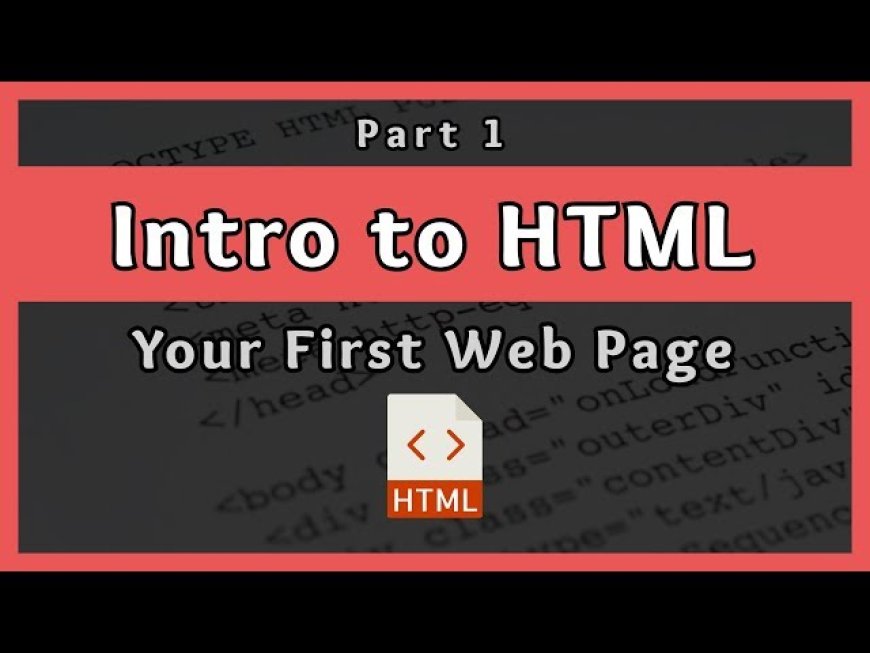Step-by-Step Guide to Create First HTML Page
Step 1: Set Up Your Development Environment Before you start coding, you'll need a text editor. You can use a simple text editor like Notepad (Windows) or TextEdit (Mac) for this purpose.

Creating your first HTML (Hypertext Markup Language) page is a fundamental step in web development. HTML is the standard markup language used to structure the content on the World Wide Web. In this step-by-step guide, I'll walk you through the process of creating your first HTML page from scratch. You won't need any prior coding experience to get started. Let's begin:
Step 1: Set Up Your Development Environment Before you start coding, you'll need a text editor. You can use a simple text editor like Notepad (Windows) or TextEdit (Mac) for this purpose. However, I recommend using a more developer-friendly code editor like Visual Studio Code, Sublime Text, or Atom, which provide features like syntax highlighting and code suggestions.
-
Download and install a code editor of your choice if you haven't already. Visual Studio Code (VSCode) is a popular choice, and it's available for Windows, macOS, and Linux.
-
Install any necessary extensions in your code editor for better HTML editing. For VSCode, you can search for extensions like "HTML Snippets" and "Live Server" and install them.
Step 2: Create a New HTML File
-
Open your code editor.
-
Create a new file by clicking on "File" and then "New File" (or press
Ctrl+Non Windows/Linux orCmd+Non macOS). -
Save the new file with a meaningful name and the
.htmlfile extension. For example, you can name it "index.html." The.htmlextension indicates that this is an HTML file.
Step 3: Write the Basic Structure of HTML
HTML documents have a specific structure with opening and closing tags. Here's a basic template you can start with:
<!DOCTYPE html>
<html>
<head>
<meta charset="UTF-8">
<title>Your Page Title</title>
</head>
<body>
<h1>Hello, World!</h1>
<p>This is your first HTML page.</p>
</body>
</html>
<!DOCTYPE html>declares that this is an HTML5 document.<html>is the root element that contains all other HTML elements.<head>contains meta-information about the document, such as the character encoding and the page title.<title>sets the title displayed in the browser tab.<body>contains the main content of your webpage.
Step 4: Add Content
You can add various HTML elements to your page to structure and format your content. For example:
<h1>: Represents a top-level heading.<p>: Represents a paragraph of text.
Here's an example of adding content:
<body>
<h1>Welcome to My First HTML Page</h1>
<p>This is a paragraph of text. You can add more text here.</p>
</body>
Step 5: Preview Your HTML Page
To view your HTML page in a web browser:
-
Save your changes in your code editor (Ctrl+S or Cmd+S).
-
Right-click on your HTML file (e.g., index.html) in your code editor and choose "Open with" or "Open in Browser." Alternatively, you can simply double-click the file from your file explorer (Finder on macOS or File Explorer on Windows).
Your web browser should open, displaying your HTML page.
Step 6: Make Changes and Experiment
HTML is a markup language, and you can experiment with different elements, attributes, and styles. Here are some things to try:
- Add more text and content.
- Experiment with different headings, paragraphs, and lists.
- Learn about HTML tags for links, images, and forms.
- Explore CSS (Cascading Style Sheets) to style your page.
Step 7: Further Learning
To become proficient in web development, consider the following:
- Learn CSS to style your HTML pages.
- Explore JavaScript to add interactivity to your web pages.
- Study responsive web design for creating mobile-friendly websites.
- Get familiar with version control systems like Git.
- Practice building more complex web applications.
Remember that web development is a vast field, and there are plenty of online tutorials and resources available to help you on your journey. Don't hesitate to seek out additional tutorials and documentation to expand your skills. Good luck with your web development endeavors!

 HSingh
HSingh